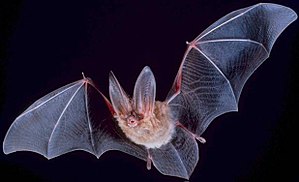Townsend long-eared
| Townsend long-eared | ||||||||||||
|---|---|---|---|---|---|---|---|---|---|---|---|---|

Townsend long-eared ( Corynorhinus townsendii ) |
||||||||||||
| Systematics | ||||||||||||
|
||||||||||||
| Scientific name | ||||||||||||
| Corynorhinus townsendii | ||||||||||||
| ( Cooper , 1837) |
The Townsend long-eared bat ( Corynorhinus townsendii ) is a bat in the smooth-nosed family .
features
| 2 | · | 1 | · | 2 | · | 3 | = 36 |
| 3 | · | 1 | · | 3 | · | 3 |
The species reaches a total length of 80 to 118 mm, including a 33 to 57 mm long tail. She has forearms 34 to 55 mm long and weighs 6.1 to 19 g. The 33 to 57 mm long ears are connected to one another on the forehead. The Townsend long-eared ear has a noticeably thin flight membrane and reaches a wingspan of 297 to 320 mm. On both sides of the snout there are glands that are visible as thick bulges. The coat is made up of hairs that are darker near the root than at the tip. Depending on the specimen, this results in a cinnamon, dark brown or gray color on the upper side, while the underside is covered by beige to light brown fur. There are 36 teeth (see tooth formula ).
distribution
This bat lives primarily in western North America from British Columbia in Canada to Oaxaca in Mexico . The main population reaches South Dakota and Oklahoma in the east . There are demarcated populations in central and eastern areas of the United States. Coniferous forests, deciduous forests near rivers, bushes or semi-deserts serve as habitats .
Way of life
The Townsend long-eared long-eared colonies , often with several hundred specimens, rest during the day in caves, in other natural cavities or in hiding places made by humans. The individuals prefer dark areas and leave them late after sunset. The species primarily hunts moths and other insects such as beetles or flies with the help of echolocation . The prey is grabbed in flight or collected by plants. A maximum flight speed of 19.8 km / h was registered for this species. She is not migratory and therefore does not undertake long migrations. In California, the largest documented distances were 32.2 km, in the southern Great Plains almost 40 km. In the cold season the Townsend long-eared hibernate or it becomes lethargic ( torpor ) in its winter quarters . Individual individuals then wrap themselves in their wings, in larger groups the animals fold their wings along their bodies. You wake up several times and sometimes change positions or winter camps. Females in California hibernate in colder places on average than males. Individual individuals lose more than half of their body weight during hibernation.
Mating occurs in late autumn or in winter between November and February. Multiple copulations occur, sometimes even when the female is frozen in winter. After that, the male sperm cells remain in the female sex tract before fertilization begins. The time of the rupture of the follicle and the duration of the gestation period depend on the age of the female, the temperature of the resting place and geographic conditions such as altitude and latitude. This means that the development of the embryo can take between 56 and 100 days. Births in California were recorded between the second half of April and the second half of July. Before the young are born, females form their own colonies in which males are not tolerated. Each female usually has only one kitten per litter, weighing 2.1 to 2.7 g at birth. It is naked and blind, the ears are initially still above the closed eyes. They straighten up after about a week, while the eyes open only a few days later. The development takes place very quickly and most young animals can fly after two and a half to three weeks, after four weeks they have almost reached the size of the adult animals. About 6 to 8 weeks after giving birth, the female will no longer give breast milk. Usually the colonies with females dissolve at the end of August.
In some populations, up to 50% of the young die before they reach their first year of life. After that, the Townsend long-eared's chances of survival increase rapidly. Individual specimens could reach an age of 21 years.
status
This bat is sensitive to disturbance from humans in the resting place. On the other hand, it uses man-made hiding places. The IUCN lists the species as Least Concern. In contrast, the two isolated eastern populations are listed by the US Fish and Wildlife Service as endangered.
Individual evidence
- ↑ Don E. Wilson , DeeAnn M. Reeder (Ed.): Mammal Species of the World . A taxonomic and geographic Reference . 3. Edition. 2 volumes. Johns Hopkins University Press, Baltimore MD 2005, ISBN 0-8018-8221-4 (English, Corynorhinus townsendii ).
- ↑ a b c d e B. J. Verts, Leslie N. Carraway (Ed.): Land Mammals of Oregon . University of California Press, 1998, ISBN 0-520-21199-5 , pp. 113-116 (English, Corynorhinus townsendii ).
- ↑ a b c d e f Jen Sullivan: Townsend's big-eared bat on the University of Michigan Museum of Zoology's Animal Diversity Web. Retrieved January 18, 2017
- ↑ a b c d e f Corynorhinus townsendii in the endangered species Red List of IUCN 2008. Submitted By: Arroyo Cabrales, J. & Álvarez-Castañeda, ST, 2008. Retrieved on 18 January 2017th
